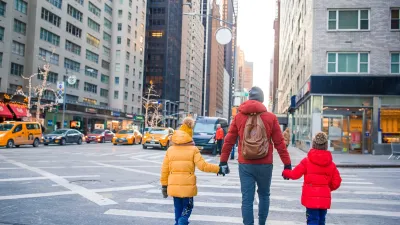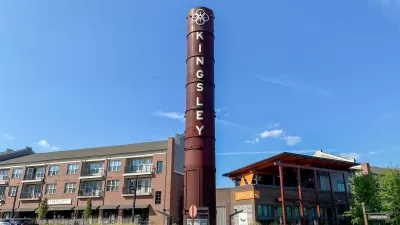In an opinion piece for The New York Times, Christopher B. Leinberger summarizes a new report he's co-authored for the Brookings Institution that demonstrates the correlation between walkability and real estate value.
Leinberger's new study, co-authored with Mariela Alfonzo, compared the values of commercial and residential real estate in the Washington, D.C. metropolitan area with an area's walkability; and their findings have proven the reversal of the common understanding of where the most valuable real estate can be found.
"Our research shows that real estate values increase as neighborhoods
became more walkable, where everyday needs, including working, can be
met by walking, transit or biking. There is a five-step 'ladder' of
walkability, from least to most walkable. On average, each step up the
walkability ladder adds $9 per square foot to annual office rents, $7
per square foot to retail rents, more than $300 per month to apartment
rents and nearly $82 per square foot to home values."
And walkable doesn't have to mean downtown. "Demand for walkable urban space extends beyond city centers to suburbs;
in metropolitan Washington, more than half of the walkable places are in
the suburbs, like Reston Town Center, 22 miles from downtown
Washington; Ballston, in Arlington County; and Silver Spring, in
suburban Maryland."
The flip side of the rising value of walkable places in the accompanying loss of affordable housing that many cities are struggling with. Leinberger proposes some short and long-term strategies for improving affordability. "To address the affordability challenge, a sensible strategy would
include changes like zoning that allows homes with units in the back or
over the garage. But the long-term solution is encouraging the building
of more walkable places, which will reduce the price premiums by
creating more supply."
FULL STORY: Now Coveted: A Walkable, Convenient Place

Alabama: Trump Terminates Settlements for Black Communities Harmed By Raw Sewage
Trump deemed the landmark civil rights agreement “illegal DEI and environmental justice policy.”

Study: Maui’s Plan to Convert Vacation Rentals to Long-Term Housing Could Cause Nearly $1 Billion Economic Loss
The plan would reduce visitor accommodation by 25% resulting in 1,900 jobs lost.

Planetizen Federal Action Tracker
A weekly monitor of how Trump’s orders and actions are impacting planners and planning in America.

Waymo Gets Permission to Map SF’s Market Street
If allowed to operate on the traffic-restricted street, Waymo’s autonomous taxis would have a leg up over ride-hailing competitors — and counter the city’s efforts to grow bike and pedestrian on the thoroughfare.

Parklet Symposium Highlights the Success of Shared Spaces
Parklets got a boost during the Covid-19 pandemic, when the concept was translated to outdoor dining programs that offered restaurants a lifeline during the shutdown.

Federal Homelessness Agency Places Entire Staff on Leave
The U.S. Interagency Council on Homelessness is the only federal agency dedicated to preventing and ending homelessness.
Urban Design for Planners 1: Software Tools
This six-course series explores essential urban design concepts using open source software and equips planners with the tools they need to participate fully in the urban design process.
Planning for Universal Design
Learn the tools for implementing Universal Design in planning regulations.
Caltrans
Smith Gee Studio
Institute for Housing and Urban Development Studies (IHS)
City of Grandview
Harvard GSD Executive Education
Toledo-Lucas County Plan Commissions
Salt Lake City
NYU Wagner Graduate School of Public Service





























